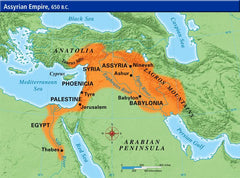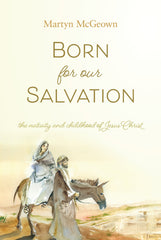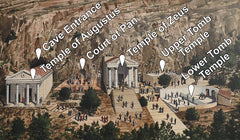Your cart is empty now.

December 15, 2019 Standard Bearer preview article
This 'Go ye into the world' article is written by Rev. Wilbur Bruinsma and will be published in the December 15, 2019 issue of the Standard Bearer.
![]() Click to read pdf as printed in the December 15, 2019 issue.
Click to read pdf as printed in the December 15, 2019 issue.
___________
Protestant Reformed Missions: The War Years
Mission Work Flounders (1940-1946): 5
There are various legitimate means evangelism committees and mission committees use to spread the gospel. One such means already faithfully used by the PRC Mission Committee was that of the printed page. During the years that war was being waged in Europe and the south Pacific, various churches, especially First PRC in Grand Rapids, published pamphlets addressing diverse doctrinal and practical issues—many of them written by Rev. Herman Hoeksema. In the twenty-fifth anniversary booklet of the Protestant Reformed Churches the author writes:
There are the pamphlets of the Sunday School Society of the First Prot. Ref. Church in Grand Rapids, and I assure you they are worthy of mention, of honorable mention. Thousands upon thousands of these pamphlets have seen the light on many and diverse biblical and Reformed subjects, and they have been spread far and wide. And their influence can hardly be underestimated.1
During the war years these pamphlets multiplied and were used extensively in evangelism outreach and by the mission committee with the prayer that they would gender interested groups of people who would seek us out to labor among them.
Worthy of note is the launching of a couple new periodicals during this period of time. The first issue of the Beacon Lights was distributed in January 1941. The aim of this periodical put out by the Young People’s Federation was not that of evangelism work, although it has been used at times where people have shown an interest in our churches. One aim of the Beacon Lights was and is “to unite all Protestant Reformed Young People’s Societies so that they may work in close unity and secure a sense of solidarity.” A second aim is “to seek the mutual edification of the members of this Federation and to strive for the development of talents as becomes Christian young people.”2 This periodical still thrives today under God’s blessing.
A second periodical named the Concordia was published by The Evangel Society of Northwest Iowa. Its initial editor-in-chief was Rev. Gerrit Vos. In his first editorial he asked his readers:
Therefore, we would kindly ask you to read the name of our paper in conjunction with the name of the society who prints it: “The Evangel Society.” We are “Concordia in Euangelio!” Our hearts together sing the everlasting song of the Gospel of God! So you see, dear friends, that these two names are advisedly chosen, in order that they might express to the whole world your and our “endeavoring to keep the unity of the Spirit in the bond of peace!” (Eph. 4:3). Agreement, unity, concord in the Gospel! It is the calling of the church to do so as long as the sun and the moon endure.3
This makes it clear that this church paper was meant to be used in the evangelism work of these churches in Iowa and Minnesota. The rubrics were divided among the ministers of the six churches there. The one somewhat strange exception is that Rev. Hubert DeWolf, co-pastor of First PRC in Grand Rapids with Rev. H. Hoeksema, was invited to join the editorial staff, to which he consented.
Now, there was nothing wrong with the Evangel Society publishing its own periodical. In fact, in the first few years of this publication, especially while Rev. Vos was its editor, the Concordia was a welcome addition to the church papers. There seemed, however, to be an ulterior motive in publishing it that did not immediately reveal itself. There was a growing dissatisfaction with what was perceived as the dominant role Rev. H. Hoeksema played in almost every labor of our churches. The Standard Bearer since October of 1924 was the unofficial voice of the Protestant Reformed Churches. Listen to the glowing appraisement of this church paper once again in the commemorative booklet of the twenty-fifth anniversary of our churches:
Although many have written on its pages, and although we will not minimize the importance and the correctness of that which was written by many of us, the main voices in the Standard Bearer were those of Revs. Hoeksema and Ophoff, the former the acknowledged leader but ably flanked by our beloved brother Ophoff, who has always been, if I may use a military phrase, the second in command.4
If you recall, in our last article we already took note of the rift that developed between the two branches of the Mission Committee. Much of this centered on the same reason: Rev. Hoeksema dominated the mission work of our churches. First PRC where he was a pastor had to be the church that carried on mission work. Rev. Hoeksema was also the dominant teacher in the seminary. Many of the ministers in the West at that time also begrudged Rev. Hoeksema for always seeming to have the final word on the floor of classis and synod.
The Concordia became a second church paper that now would compete with the Standard Bearer as a recognized voice in our churches. It could also be used, so it was felt, by churches doing mission work as the paper of choice since it was written with an evangelistic emphasis. That this added to the tension developing in the churches is evident from the meager review this church paper received in the twentieth-fifth anniversary booklet:
Another important publication is Concordia, a biweekly, and published in the Middle West.... Its scope is not so wide as the Standard Bearer nor is its material as heavy, but it publishes the same truth, although more within our own constituency, rather than in the whole wide world.5
In years to come the Concordia was utilized by those anxious to oppose Hoeksema by compromising the truth of an unconditional covenant. As we will discover, church growth was more important to them than maintenance of the truth. The Concordia gave opportunity for men who embraced the error of a conditional covenant to make their voices heard in the PRC.
The publication of new church papers was not the only new development during the war years. It was also a time that radio had come into its own. It was the latest technology and a means to reach thousands of people with the gospel. Religious programming had become popular in various places in the United States. It was only natural that our churches too would seize the opportunity to use this legitimate means to proclaim the precious truths of the gospel.
First PRC of Grand Rapids again led the way. On October 12, 1941 the Reformed Witness Hour (then named “The Protestant Reformed Hour”) was launched with its first program being, “God is God.” Rev. Hoeksema was chosen as the first radio pastor—another one of his many ventures! The broadcast still airs today over many different radio stations in the United States and abroad. In fact, just recently the Reformed Witness Hour commemorated its 4,000th broadcast (Sept. 2019)! In August of 1945 the Consistory of First PRC adopted the Reformed Witness Hour as her mission endeavor and placed it as a line item on the general fund budget.
But the Reformed Witness Hour was just one of many different broadcasts that sprung up among our various PRCs. The “Protestant Reformed Hour On the Air” was sponsored by our churches in Redlands and Bellflower, California. Rev. G. Vos and Rev. L. Doezema were the radio pastors. Sadly, this broadcast discontinued its outreach about a year later.
The churches in Northern Iowa and Edgerton through their young people’s societies sponsored the “Sovereign Grace Hour” beginning in April 1942. Rev. W. Verhil was the radio pastor until his death. At that time the various ministers in Iowa took turns. This broadcast was in existence until 1950, under the supervision of the various consistories of NW Iowa and Edgerton.
The “Reformed Truth Hour” sponsored jointly by Oaklawn and South Holland PRCs (IL) began live broadcasting on Sunday evening, September 8, 1946. Rev. M. Schipper together with Rev. M. Gritters (soon replaced by Rev. G. Vandenberg) were the radio pastors. It must be remembered that although broadcasts were recorded on reel-to-reel tape, it was not easy to mass produce such tapes and send them to various places in the United States. Though radio was an amazing technology it was not developed as it is today. Today mp3 recordings are made and shipped to various radio stations within minutes to be put on the air. In the 1940s a large reel-to-reel tape needed to be recorded, spliced, and then reproduced. This was not simple or cost effective. For that reason, the radio broadcasts that aired out of Hammond, Indiana were messages spoken on the air live. Incidentally, this broadcast was instrumental in bringing Rev. R.C. Harbach to our churches as a minister.
We only make mention of the “Protestant Reformed Hour” produced by Oskaloosa and Pella PRCs (IA) somewhat later in 1949. The messages in these areas were given by Revs. J. Howerzyl and M. Gritters alternately.
All of these broadcasts, with the exception of the Reformed Witness Hour, abruptly ended with the controversy of 1953. But, certainly, during the early 1940s our churches were attempting to reach out by means of radio in order to promote the truth as God had graciously given it to the PRC. Yet, mission work floundered because the distinctive Reformed truths our churches preached no longer held an appeal to most within the sphere of Reformed churches. Fewer groups of people were searching us out in order to be formed into a church. Through radio our churches were able to extend our message to a broader range of people. This helped renew our zeal for mission work.
But for all that, the extension of our churches by means of mission work had dramatically slowed down since the 1930s. The beautiful doctrines of grace given us as churches by God’s grace are true but not popular. The PRC in the early 1940s numbered about 5,000 souls—so, so small in comparison to our mother church, the Christian Reformed Church. In fact, we were tiny in comparison to most of the major Reformed churches. And we were not growing! Despite all our efforts, we were not getting any larger! Along with a dissatisfaction with the focus in the East on Rev. Hoeksema there was another growing restlessness on the part of many, including many of the clergy. They did not like being small and despised. They had an unhealthy desire that our denomination grow to a respectable size. This was not happening as they had hoped. There was not enough progress, not enough growth through our mission work. As time and circumstances progressed in the next several years, such restlessness bred in many a willingness to compromise the truth in order to grow.
Add that restlessness to the uncompromising character of Rev. Hoeksema and those who stood alongside of him in the years to come, and our churches were ripe for disaster! The occasion for this, sad to say, was the mission work of our churches in the late 1940s and early 1950s. This history of missions waits us in the next set of articles.
______________
1 The Protestant Reformed Churches—Twenty Fifth Anniversary 1925-1950, (Grand Rapids, MI, 1950), 99.
2 Beacon Lights, vol. 1, No. 1: January 1941 (Grand Rapids, MI).
3 Concordia, vol. 1, No. 1: February 1, 1944, (Hull, IA), 1.
4 The PRC—Twenty-Fifth Anniversary, 97.
5 PRC—Twenty-fifth Anniversary, 99
The content of the article above is the sole responsibility of the article author. This article does not necessarily reflect the opinions and beliefs of the Reformed Free Publishing staff or Association, and the article author does not speak for the RFPA.

Donate
Your contributions make it possible for us to reach Christians in more markets and more lands around the world than ever before.
Select Frequency
Enter Amount










